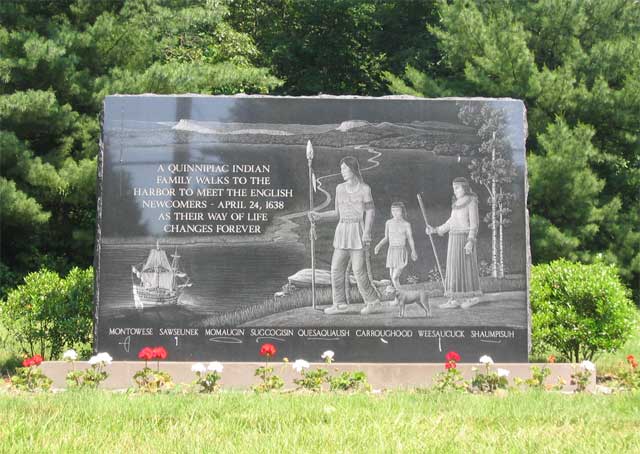The Quinnipiacs of New Haven Harbor

Memorial to the Quinnipiac Indian Tribe, Fort Worcester Park, Townsend Avenue, New Haven
Long before Columbus and other explorers came to the New World, the tribes of the Algonquin nation claimed the land we now call the Northeast. Specifically, an early Dutch map plotted by Adrian Black in 1613 shows the coastline and Indian tribes of early Connecticut. ("Qua-neh-ta-cut", as the Indians called it, meaning long tidal river.) Surrounding the present New Haven Harbor from Milford to East Haven lived the Quinnipiacs. These early native Americans migrated seasonally, allowing them to enjoy the cool breezes of the seacoast in the summer, and the shelter of the wooded inland valleys in the winter.
At that time, the winter forests of the present day North Haven, Wallingford and Meriden were abundant with wolves, bear, moose, dear and wild cats. There were also otter, fox, raccoon, woodchucks and mink. These animals along with ducks, geese, pigeons and teal were hunted by the Quinnipiacs with bows and arrows for food and furs. Their winter woodland homes were made of sturdy poles set firmly in the ground, bent and fastened at the top and covered with bark. Simply furnished, these homes had wooden dishes, bowls, spoons, woven baskets and floor mats.
The Quinnipiacs summered on the shoreline of New Haven Harbor were all kinds of shellfish, clams, oysters and mussels were harvested and eaten, the shells of which, once discarded in piles, are still in evidence today. These Indians fished in canoes using hooks, spears and nets. Wild strawberries, blackberries and warble berries growing the shore also supplemented many Indian meals.
Little farming aside from growing tobacco was done by Indian men. This left the difficult chore of raising beans and corn to the women and children. Farming was particularly difficult because the only tools of the time were wooden spades or large shells fastened to wooden handles. From the vegetables, a staple of Indian Diet called "succotash" was made. This food baked ion earthen pots was sometimes seasoned with fish. Cornmeal cakes, another favorite food, was prepared by wrapping the meal in leaves and roasting it in hot ashes. And so lived the Indians, known as the Quinnipiacs, providing the fundamentals of survival for themselves as best they could until the early 1600's.
Although the Dutch early on had claimed Connecticut, by 1638 the English led by Theophilus Eaton and John Davenport were founding a settlement at present day New Haven on land belonging to the Quinnipiac Tribe. Because these leaders had not secured a charter from the English king, and therefore had no legal claim to the land, felt it fair and in their best interest to pay the Quinnipiacs. By this time, due to wars with other tribes, starvation due to poor harvests and disease, few Indians were left of the once numerous tribes, their numbers had dwindled to some 50 - 60 members. The Quinnipiac sachem Momauguin, from what is East Haven, and chief Montowese from the land beyond East Rock (North Haven) signed a treaty with the eager English. This treaty granted all rights to the land, rivers, ponds, and trees, extending as far east, west, north and south as the Quinnipiacs owned to them. So in exchange for some two dozen coats, a dozen each of spoons, hoes, hatchets, bowls, two dozen knives and scissors, the land that is now New Haven, East Haven, Branford, North Branford, North Haven, Wallingford, CHeshire, Hamden, Bethany, Woodbridge and Orange became the property of the English.
Mr. John Stanton of the Hartford settlement brokered the 1638 deal being the only person who could speak the language of the Quinnipiacs. In return for giving up everything including the land that they lived on, the Quinnipiacs asked for three things only; a place in what is now East Haven where they could plant their corn; the right to hunt and fist in and on the lands they given up; and protection from the English against the Mohawks, Pequots and their other tribal enemies.
So a great tract of land whose worth today cannot even be calculated was exchanged for a pitifully small sum to the Quinnipiacs. In the end, the tribe trusted the English and the terms of the treaty and faithfully observed their agreement.
This article was prepared by a Fort Nathan Hale Restoration Projects, Inc. board member who has asked to remain anonymous. Material came from the following books:
Visions in the Sky-New Haven"s Early Years 1638-1783- Myrna Kagan
The People of Connecticut-Warren J. Halliburton

